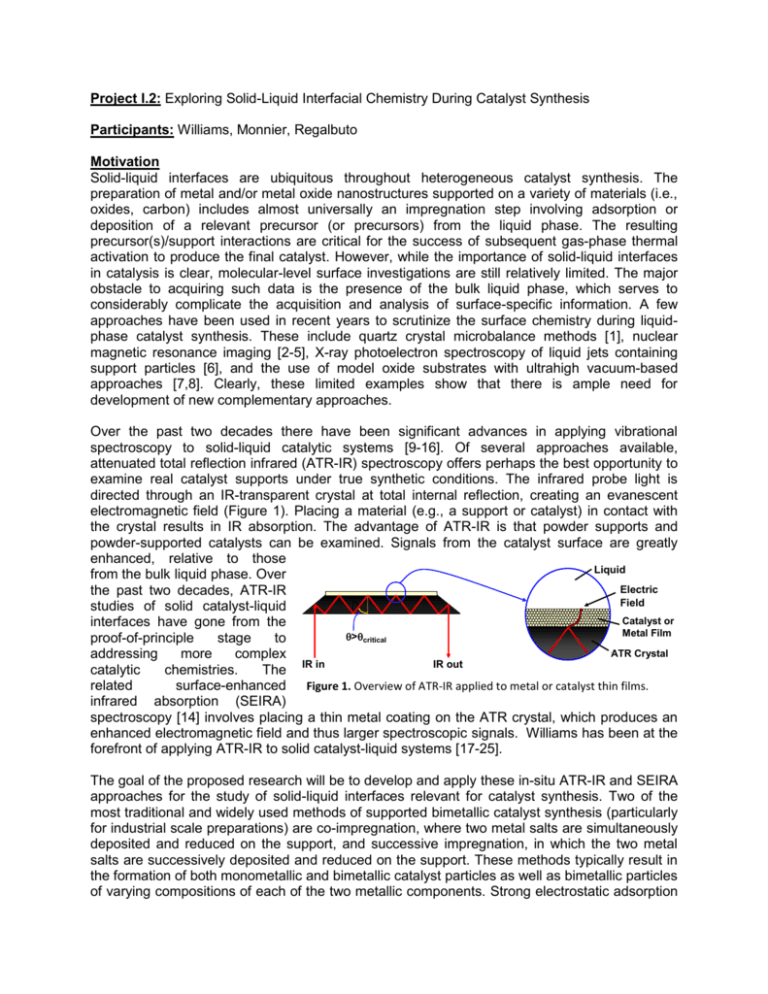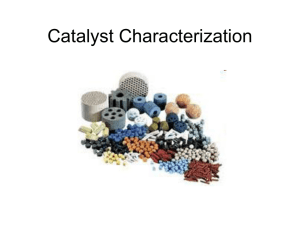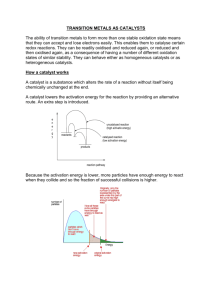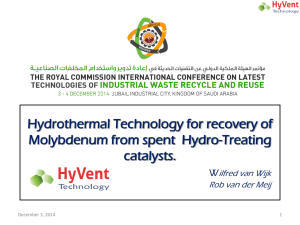Exploring Solid-Liquid Interfacial Chemistry During Catalyst Synthesis
advertisement

Project I.2: Exploring Solid-Liquid Interfacial Chemistry During Catalyst Synthesis Participants: Williams, Monnier, Regalbuto Motivation Solid-liquid interfaces are ubiquitous throughout heterogeneous catalyst synthesis. The preparation of metal and/or metal oxide nanostructures supported on a variety of materials (i.e., oxides, carbon) includes almost universally an impregnation step involving adsorption or deposition of a relevant precursor (or precursors) from the liquid phase. The resulting precursor(s)/support interactions are critical for the success of subsequent gas-phase thermal activation to produce the final catalyst. However, while the importance of solid-liquid interfaces in catalysis is clear, molecular-level surface investigations are still relatively limited. The major obstacle to acquiring such data is the presence of the bulk liquid phase, which serves to considerably complicate the acquisition and analysis of surface-specific information. A few approaches have been used in recent years to scrutinize the surface chemistry during liquidphase catalyst synthesis. These include quartz crystal microbalance methods [1], nuclear magnetic resonance imaging [2-5], X-ray photoelectron spectroscopy of liquid jets containing support particles [6], and the use of model oxide substrates with ultrahigh vacuum-based approaches [7,8]. Clearly, these limited examples show that there is ample need for development of new complementary approaches. Over the past two decades there have been significant advances in applying vibrational spectroscopy to solid-liquid catalytic systems [9-16]. Of several approaches available, attenuated total reflection infrared (ATR-IR) spectroscopy offers perhaps the best opportunity to examine real catalyst supports under true synthetic conditions. The infrared probe light is directed through an IR-transparent crystal at total internal reflection, creating an evanescent electromagnetic field (Figure 1). Placing a material (e.g., a support or catalyst) in contact with the crystal results in IR absorption. The advantage of ATR-IR is that powder supports and powder-supported catalysts can be examined. Signals from the catalyst surface are greatly enhanced, relative to those Liquid from the bulk liquid phase. Over Electric the past two decades, ATR-IR Field studies of solid catalyst-liquid Catalyst Catalystor interfaces have gone from the Metal Film Film > proof-of-principle stage to critical Ge ATRelement Crystal addressing more complex IR in IR out catalytic chemistries. The related surface-enhanced Figure 1. Overview of ATR-IR applied to metal or catalyst thin films. infrared absorption (SEIRA) spectroscopy [14] involves placing a thin metal coating on the ATR crystal, which produces an enhanced electromagnetic field and thus larger spectroscopic signals. Williams has been at the forefront of applying ATR-IR to solid catalyst-liquid systems [17-25]. The goal of the proposed research will be to develop and apply these in-situ ATR-IR and SEIRA approaches for the study of solid-liquid interfaces relevant for catalyst synthesis. Two of the most traditional and widely used methods of supported bimetallic catalyst synthesis (particularly for industrial scale preparations) are co-impregnation, where two metal salts are simultaneously deposited and reduced on the support, and successive impregnation, in which the two metal salts are successively deposited and reduced on the support. These methods typically result in the formation of both monometallic and bimetallic catalyst particles as well as bimetallic particles of varying compositions of each of the two metallic components. Strong electrostatic adsorption (SEA) [1,26-28] and electroless deposition (ED) [29-32] are scalable, synthetic approaches that are typically more effective for producing supported monometallic and bimetallic catalysts with desired properties. In SEA, control of pH relevant to the potential of zero charge (PZC) of a 𝑦+ support (S) allows predictable quantities of metal ions (e.g., M1 , M2𝑧+ ) to be adsorbed. This allows highly dispersed M1, M2, and M1M2 species to be formed after appropriate thermal activation treatments. In ED, a supported monometallic catalyst (e.g., M1/S) is placed in an aqueous bath with a second metal ion (Mz+ 2 ), reducing agent (RA), and possibly stabilizing 𝑦+ agent. Through catalytic (on M1) and autocatalytic (on M2) processes, M2 is reduced and deposited to form a bimetallic catalyst (M2M1/S). In both SEA and ED, the adsorption and/or reduction of metal precursor ions (sometimes coordinated with ligands) on the support and/or metal surface in the liquid (usually aqueous) phase is critical. In SEA, the synthesis of bimetallic catalysts requires the co-adsorption of 𝑦+ M1 and M2𝑧+ . The competitive adsorption kinetics, and the molecular interactions between these co-adsorbed precursors, is critical. In the case of sequential SEA for bimetallics [28], M2𝑧+ is adsorbed selectively onto M1OX (as opposed to S) through control of the PZC. The state of supported M1OX during this process is critical to its success. In ED, supported monometallic nanoparticles can undergo sintering in solution at room temperature in the presence of various reducing agents [30]. Unpublished work by the PI further suggests that this effect is particularly pronounced for very small metal nanoparticles (i.e., < 3 nm). A second issue is the difficulty of producing high M2 coverage on M1 while avoiding deposition of large 3D clusters of the former through autocatalytic deposition. Even when RA activation is preferred on M1 over M2, this situation often persists [29,31]. In both synthetic approaches, the adsorbed species on the metal/support surface (i.e., ionic precursors, activated RA, M2𝑧+ , stabilizers) will play key roles in governing these phenomena. Hypothesis: The use of ATR-IR and SEIRA spectroscopy can directly probe support surfaces in situ under actual liquid-phase synthetic conditions. Objective: Develop a detailed understanding of surface chemistry during SEA and ED processes, leading to rational strategies for optimizing bimetallic catalyst synthesis. Research Plan: The following aspects of catalyst synthesis will be examined with spectroscopy: A) generally, adsorption of metal salt precursors on the support surface and the affect of associated nonmetallic species (whether inorganic counter ions or organic ligands) on these processes; B) in ED, the influence of additives such as reducing agents and stabilizers on surface speciation and the deposition process; C) in SEA, the stability and state of surface oxides during selective sequential electrostatic adsorption of a second metal precursor. The following are specific systems that will be examined in this first year project: 1) The SEA method has been used effectively to produce bimetallic catalysts using the sequential approach described above. For example, the SEA synthesis of Mn-Rh/SiO2 bimetallic catalysts for alcohol synthesis from syngas has been recently reported [28]. In the liquid phase, the SEA of MnO4- species onto supported Rh2O3 (and its stability) will be tracked as a function of solution conditions. The gas-phase activation to break Mn- and Rh-O bonds to form MnRh bimetallic particles will also be explored (using Raman spectroscopy), with a view towards correlating the resulting catalyst structure with the speciation observed during synthesis. 2) The ED method has been used to deposit Ag on highly dispersed supported Pt to produce catalysts for selective hydrogenation reactions. This system has shown evidence of Pt particle sintering [30] during ED, as shown by the scanning transmission electron micrographs (STEM) and particle size histograms in Figure 2. In addition, this system shows limited catalytic deposition (i.e., Ag on Pt) effectiveness [29,31], in that high coverages of Ag are difficult to attain. Pt nanoparticles (1-3 nm) supported on SiO2 and Al2O3 will be exposed to ED baths containing AgNO3 with formaldehyde, dimethylamine borane, and hydrazine. First, reducing agent adsorption onto catalysts will be examined, along with the bare supports and a thin polycrystalline Pt metal film. Next, AgNO3 will be added to the system, and its effect on reducing agent surface speciation will be examined. CO will be used to probe sintering and deposition processes, and as a possible surface modifier during ED synthesis. Figure 2. Example of particle sintering occurring during ED of Ag on Pt/SiO2. Taken 3) The adsorption of metal precursors onto carbon from Ref. 30. supports is a critical aspect to synthesizing highlydisperse catalysts for pharma applications (see Projects ???), as well as fuel cell and biomass conversion reactions. SEIRA has been used effectively to probe C-supported metal catalysts during electrocatalytic reactions. As a prelude to studying Pd precursor-C interactions on graphene and carbon nanotubes, adsorption of a CO as a probe molecule will be studied. In addition to in-situ infrared spectroscopy, Raman spectroscopy will be used to probe the structure of supported oxide species during synthesis steps in the liquid phase. Furthermore, the surface speciation observed during liquid phase syntheses will be correlated with resulting activated catalyst structures as determined by techniques such as chemisorption, X-ray diffraction, scanning transmission electron microscopy, and X-ray photoelectron spectroscopy. First Year Deliverable: ATR-IR studies of Ag ED on Pt/SiO2 and MnO4- SEA onto supported Rh2O3/SiO2. Proof of principal of SEIRA of Pd/graphene catalyst. First Year Milestone(s) 1) Months 1-6: ATR-IR spectroscopy of reducing agent adsorption on SiO2 and Pt/SiO2; ATR-IR and Raman spectroscopy of MnO4- on Rh2O3/SiO2 in solution; 2) Months 7-12: ATR-IR studies during Ag ED on Pt/SiO2; FTIR and Raman of MnO4-/Rh2O3 reduction in the gas phase; demonstration of ATR-IR of CO adsorption on Pd/graphene. Cost: $60,000 for one year (one graduate student/post doc. and supplies) References 1. Hervier, A.; Blanchard, J.; Costentin, G.; Regalbuto, J. R.; Louis, C.; Boujday, S. “The Genesis of a Heterogeneous Catalyst: In Situ Observation of a Transition Metal Complex Adsorbing onto an Oxide Surface in Solution,” Chem. Commun. 50(19), 2409-2411 (2014). 2. Espinosa-Alonso, L.; Beale, A. M.; Wechhuysen, B. M., “Profiling Physicochemical Changes within Catalyst Bodies during Preparation: New Insights from Invasive and Noninvasive Microspectroscopic Studies,” Acct. Chem. Res. 43(9), 1279-1288 (2010). 3. Lysova, A. A.; Bergwerff, J. A.; Espinosa-Alonso, L.; Weckhuysen, B. M.; Koptyug, I. V., “Magnetic Resonance Imaging as an Emerging Tool for Studying the Preparation of Supported Catalysts,” Appl. Catal. A: Gen. 374, 126-136 (2010). 4. 5. 6. 7. 8. 9. 10. 11. 12. 13. 14. 15. 16. 17. 18. 19. 20. 21. Espinosa-Alonso, L.; Lysova, A. A.; de Peinder, P.; de Jong, K. P.; Koptyug, I. V.; Weckhuysen, B. M., “Magnetic Resonance Imaging Studies on Catalyst Impregnation Processes: Discriminating Metal Ion Complexes within Millimeter-Sized γ-Al2O3 Catalyst Bodies,” J. Am. Chem. Soc. 131, 6525-6534 (2009). Lysova, A. A.; Koptyug, I. V.; Sagdeev, R. Z.; Parmon, V. N.; Bergwerff, J. A.; Weckhuysen, B. M., “Noninvasive In Situ Visualization of Supported Catalyst Preparations Using Multinuclear Magnetic Resonance Imaging,” J. Am. Chem. Soc. 127, 11916-11917 (2005). Brown, M. A.; Beloqui Redondo, A.; Sterrer, M.; Winter, B.; Pacchioni, G.; Abbas, Z; Bokhoven, J. A., “Measure of Surface Potential at the Aqueous-Oxide Nanoparticle Interface by XPS from a Liquid Microjet,” Nano Lett. 13, 5403-5407 (2013). Sterrer, M.; Freund, H.-J. “Towards Realistic Surface Science Models of Heterogeneous Catalysts: Influence of Support Hydroxylation and Catalyst Preparation Method,” Catal. Lett. 143, 375-385 (2013). Wang, H.; Ariga, H.; Dowler, R.; Sterrer, M.; Freund, H.-J., “Surface Science Approach to Catalyst Preparation - Pd Deposition onto Thin Fe3O4(111) Films from PdCl2 Precursor,” J. Catal. 286, 1-5 (2012). Weaver, M. J.; Zou, S. “Vibrational Spectroscopy of Electrochemical Interfaces: Some Walls and Bridges to Surface Science Understanding,” Adv. Spectrosc., Clark, R. J. H; Hester, R. E.; Eds.; Wiley: Chichester, UK, 26, 219 (1998). Foettinger, K.; Weilach, C.; Rupprechter, G. “Sum Frequency Generation and Infrared Reflection Absorption Spectroscopy,” Edited by Che, M.; Vedrine, J. C., Characterization of Solid Materials and Heterogeneous Catalysts 1, 211 (2012). Zaera, F. “Probing Liquid/Solid Interfaces at the Molecular Level,” Chem. Rev. 112(5), 2920 (2012). Mojet, B. L.; Ebbesen, S. D.; Lefferts, L. “Light at the Interface: The Potential of Attenuated Total Reflection Infrared Spectroscopy for Understanding Heterogeneous Catalysis in Water,” Chem. Soc. Rev. 39, 4643 (2010). Andanson, J.; Baiker, A. “Exploring Catalytic Solid/Liquid Interfaces by In Situ Attenuated Total Reflection Infrared Spectroscopy,” Chem. Soc. Rev. 39, 4571 (2010). Aroca, R. F.; Ross, D. J. “Surface-Enhanced Infrared Spectroscopy,” Applied Spectroscopy 58(11), 324A-338A (2004). Li, J.-T.; Zhou, Z.-Y.; Broadwell, I.; Sun, S.-G. “In-Situ Infrared Spectroscopic Studies of Electrochemical Energy Conversion and Storage” Acct. Chem. Res. 45(4), 485-494 (2012). Sharma, B.; Frontiera, R. R.; Henry, A.-I.; Ringe, E.; Van Duyne, R. P. “SERS: Materials, Applications, and the Future,” Mater. Today (Oxford, United Kingdom) 15(1-2), 16 (2012). Ortiz-Hernandez, I.; Williams, C. T. “In situ Studies of Butyronitrile Adsorption and Hydrogenation on Pt/Al2O3 Using Attenuated Total Reflection Infrared Spectroscopy,” Langmuir 23(6), 3172 (2007). Ortiz-Hernandez, I.; Owens, D. J.; Strunk, M. R.; Williams, C. T. “Multivariate Analysis of ATR-IR Spectroscopic Data: Applications to the Solid-Liquid Catalytic Interface,” Langmuir, 22, 2629 (2006). Ortiz-Hernandez, I.; Williams, C. T. “In-Situ Investigation of Solid-Liquid Catalytic Interfaces by Attenuated Total Reflection Infrared Spectroscopy,” Langmuir, 19, 2956 (2003). Liu, D.; Gao, J.; Murphy, C. J.; Williams, C. T. “In-Situ Attenuated Total Reflection Infrared Spectroscopy of Dendrimer-Stabilized Platinum Nanoparticles Adsorbed on Alumina,” J. Phys. Chem. B 108(34), 12911 (2004). Sun, X.; Williams, C. T. “In-situ ATR-IR Investigation of Methylcinnamic Acid Adsorption and Hydrogenation on Pd/Al2O3,” Catal. Commun. 17(1), 13-17 (2012). 22. 23. 24. 25. 26. 27. 28. 29. 30. 31. 32. Tan, S.; Sun, X.; Williams, C. T., “In Situ ATR-IR Study of Prochiral 2-Methyl-2-Pentenoic Acid Adsorption on Al2O3 and Pd/Al2O3,” Phys. Chem. Chem. Phys. 13, 19573-19579 (2011). Tan, S.; Williams, C. T. “An In Situ Spectroscopic Study of Prochiral Reactant-Chiral Modifier Interactions on Palladium Catalyst: Case of Alkenoic Acid and Cinchonidine in Various Solvents,” J. Phys. Chem. C 117(35), 18043-18052 (2013). Zapata, R. B.; Luz Villa, A.; Montes de Correa, C.; Williams, C. T. “In situ FTIR Spectroscopic Studies of Limonene Epoxidation over PW-Amberlite,” Appl. Catal. A: Gen. 365(1), 42-47 (2009). Cortes-Concepcion, J. A.; Williams, C. T.; Amiridis, M. D. “ATR-IR Study of the Adsorption of 2′-Hydroxyacetophenone and Benzaldehyde on MgO,” Catal. Commun. 16(1), 198-204 (2011). Regalbuto, J. R., “Chapter 3: Electrostatic Adsorption” in Synthesis of Solid Catalysts, de Jong, K., ed., Wiley-VCH Verlag, (2009). Schreier, M.; Timmons, M.; Feltes, T.; Regalbuto, J. “The Determination of Surface Charging Parameters for a Predictive Metal Adsorption Model.” J. Colloid Interf. Sci. 348, 571 (2010). Liu, Jingjing; Tao, Runzhe; Guo, Zhao; Regalbuto, J. R.; Marshall, C. L.; Klie, R. F.; Miller, J. T.; Meyer, R. J. “Selective Adsorption of Manganese onto Rhodium for Optimized Mn/Rh/SiO2 Alcohol Synthesis Catalysts,” ChemCatChem 5(12), 665-3672 (2013). Schaal, M. T.; Pickerell, A. C.; Williams, C. T.; Monnier, J. R. “Characterization and Evaluation of Ag-Pt/SiO2 Catalysts Prepared by Electroless Deposition,” J. Catal. 254(1), 131-143 (2008). Schaal, M. T.; Rebelli, J.; McKerrow, H. M.; Williams, C. T.; Monnier, J. R. “Effect of Liquid Phase Reducing Agents on the Dispersion of Supported Pt Catalysts,” Appl. Catal. A: Gen. 382(1), 49-57 (2010). Rebelli, J.; Rodriguez, A. A.; Ma, S.; Williams, C. T.; Monnier, J. R. “Preparation and Characterization of Silica-Supported, Group IB-Pd Bimetallic Catalysts Prepared by Electroless Deposition Methods,” Catal. Today, 160(1), 170-178 (2011). Rodriguez, A. A.; Williams, C. T.; Monnier, J. R. “Selective Liquid-Phase Oxidation of Glycerol over Au-Pd/C Bimetallic Catalysts Prepared by Electroless Deposition,” Appl. Catal. A: Gen., 475, 161-168 (2014).







